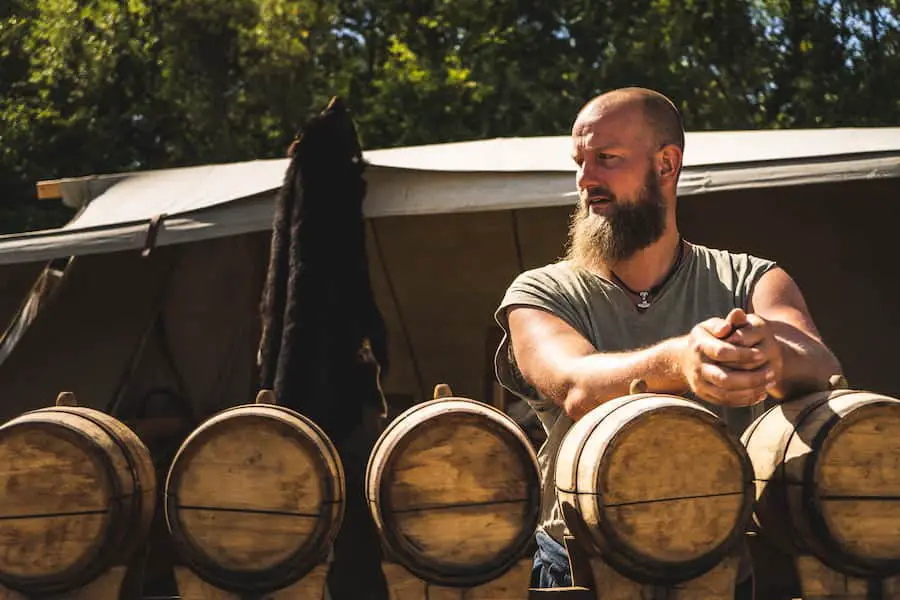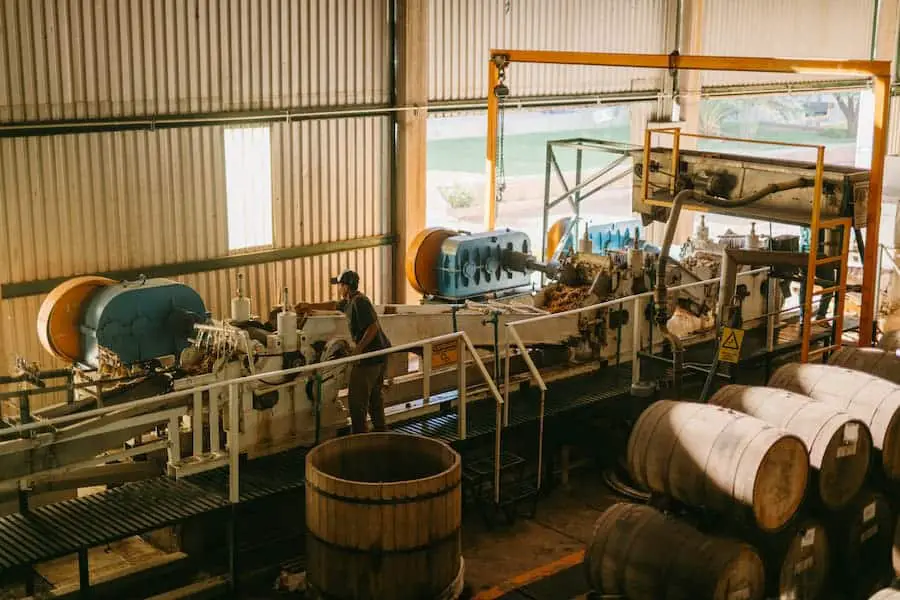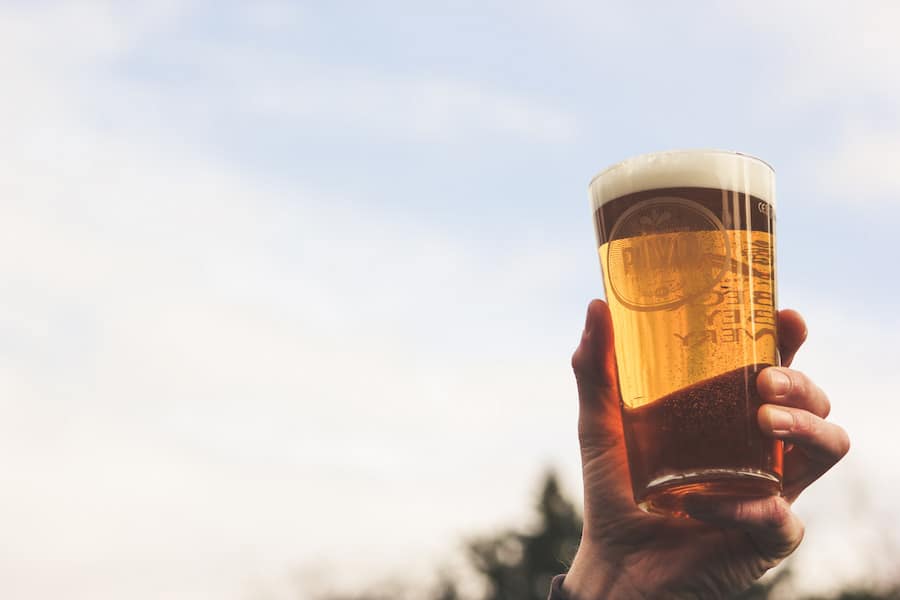If you buy something through a link in our posts, we may get a small share of the sale.
How long does it take to brew beer? It is a question that many people often ask. Beer enthusiasts love the smell and taste of freshly brewed beer, and they want to know how long it takes to make this wonderful beverage to drink.
Contents
How Long Does It Take to Brew Beer?
The average time to brew a quality beer batch is four to eight weeks depending on the recipe and type of beer being brewed. Many things go into the brewing process, and each beer has its own unique set of ingredients, methods, and brewing time to achieve the perfect flavor.
Brewing beer is a process that has been around for centuries and has evolved over time. Getting the best out of the ingredients and creating a delicious, balanced beer is an art that takes time and practice to perfect.

Brewing Beer: The Process
Many different factors can affect how long it takes to brew beer. The room’s temperature, the type of yeast in use, the recipe, and even the weather can all play a part in how long the brewing process takes.
Heating the Ingredients to Create Wort
The ingredients needed to brew beer are malt, hops, yeast, and water. I can get malt from barley, wheat, or rye grains. The grains are soaked in hot water, which starts the germination process. This process is then stopped by heating the grains, which produce malt.
Hops are a type of flower added to the beer during the brewing process. Hops add bitterness, flavor, and aroma to the beer. Yeast is a fungus used to ferment the sugar in the wort and produce alcohol. The type of yeast will determine the flavor of the beer.
I then combine malt, hops, yeast, and water to create a sugary liquid called wort. This wort is then cooled, adding yeast to start the fermentation process.
Fermenting the Beer
Fermenting is when the yeast eats the sugars in the wort and produces alcohol and carbon dioxide. It is a crucial stage that will determine the flavor and alcohol content of the beer. The longer the yeast is left to work on the sugar, the higher the alcohol content.
The fermentation process has two main stages: primary and secondary fermentation.
- Primary fermentation is the initial stage where the yeast is first added to the wort. The yeast will eat the sugars and produce alcohol and carbon dioxide. This stage usually lasts for a few days to a week.
- Secondary fermentation is the final stage of fermentation, where the beer is left to mature. The stage can last for a few weeks to a few months. The yeast will continue to eat the sugar and produce alcohol during this stage and will also start to drop out of the beer.
Bottle Conditioning the Beer
Bottle Conditioning the Beer is an essential step in the brewing process. Bottle conditioning is when the beer is carbonated in bottles. This is done by adding sugar and yeast to the beer just before bottling. The yeast will eat the sugar and produce carbon dioxide, carbonating the beer.
Many brewers add some fresh hops to the beer during bottle conditioning. This adds bitterness, flavor, and aroma to the beer. It also helps to stabilize the beer and prevent it from going bad.
Packaging and Carbonating the Beer
After fermentation is complete, the beer is bottled or kegged. Carbon dioxide is added to the beer, which gives it its fizzy appearance and taste.
The beer bottles are sanitized, and the caps are sealed. The beer is then left to carbonate for two weeks. Remember to consume the beer after two weeks, as this is the maturity period. Drinking it before the maturity period might not give you the best flavor.

Brewing Beer at Home
If you want to try your hand at brewing your own beer, there are many kits available that will help you get started. These kits come with all the ingredients and instructions you need to make your own beer.
Homebrewing is a great way to experiment with different flavors and types of beer. You can also customize the recipe to make the beer exactly how you like it.
Brewing your own beer is a fun and rewarding experience. Not only will you have delicious beer to drink, but you will also have a sense of accomplishment knowing that you made it yourself.
Is It Possible to Brew Beer in a Week?
The simple answer is yes, provided you have all the necessary equipment and ingredients on hand. However, most brewers will tell you that the quality of your beer will suffer if you try to rush the process.
Most homebrewers will tell you that it takes about two weeks to produce a good quality beer. This includes the fermentation process, which can take up to a week on its own. There are plenty of shortcuts that one can take to speed up the brewing process.
The steps below will help you brew a basic all-grain beer in about seven days.
- The first day: Make The Mash- ensure you have a large pot that can hold at least four gallons of water. The mash will need to be held at a specific temperature to convert the starch in the grain into fermentable sugar. Add your grain to the pot and slowly add hot water, stirring constantly. The target temperature is 154 degrees Fahrenheit.
- The second day: Sparge and Boil- once the mash has reached the target temperature, you need to sparge (rinse) the grain. You can pour hot water over the grain bed until the desired volume is reached. Bring the wort (unfermented beer) to a boil and add your hops. The boiling process will last for one hour.
- The third-fifth day: Ferment- the wort will need to be cooled down to room temperature before transferring to a fermentation vessel. Add yeast and seal the vessel. Increase the temperature to about 80 degrees F and let the beer ferment. Increasing temperature speeds up the fermentation process.
- The Sixth day: Cool the Beer. You can put it in a fridge or use a cold water bath to cool it down. Cooling it ensures the yeast will not start working again and produce off-flavors. The precipitates will also fall out of suspension and can be removed.
- The Seventh-day: Bottle the Beer. Sanitize your bottles and caps and fill them with the beer. Put the cap on using the best bottle capper and store it in a cool, dark place for about seven hours. Carbonation will take place during this time. After that, you can enjoy your beer!
Brewing a beer in a week is possible. However, the quality will likely be lower than if you brew it for two weeks. Rushing the process can produce off-flavors and unwanted sediment in your beer. The steps above will help you brew a basic all-grain beer in about seven days, a lot shorter than making your own sake.
How to Taste Beer
Tasting beer is an important part of the brewing process. It allows brewers to evaluate the beer and make adjustments to the recipe if needed. There are several things to look for when tasting beer:
- Appearance: Look at the color of the beer and judge how clear it is. Clarity indicates how well the beer was filtered or centrifuged.
- Aroma: Take a deep breath and evaluate the intensity of the aroma. The most common aromas are hops, malt, and yeast.
- Flavor: Judge how the flavor of the beer matches the aroma. Hops provide bitterness, malt provides sweetness, and yeast provides sourness or fruity esters.
- Aftertaste: Judge how long the aftertaste lasts and whether it is unpleasant or not.
Beer Styles
There are many different beer styles, each with its own unique flavor profile, and the duration it takes to brew them will vary. Some of the more popular beer styles are listed below:

- Ale: Ales are brewed with top-fermenting. The brewing process is similar to that of lagers, though the fermentation process occurs at higher temperatures. This style of beer is typically fruitier and less bitter than lagers. It takes about two weeks for fermentation and another two weeks for carbonation and conditioning.
- Lager: Lagers are brewed with bottom-fermenting yeast and typically have a crisper, cleaner flavor than ales. The brewing process is similar to that of ales, though the fermentation process takes place at lower temperatures compared to ale’s. Lagers require a longer conditioning period than ales, typically four to eight weeks or even longer.
- Stout: Stouts are dark, rich, and roasty in flavor. They are brewed with roasted malts and typically have chocolate or coffee-like flavor. This style of beer takes a longer time compared to other styles. A 10% imperial stout can take up to three months from raw to packaged product. A higher ABV may take even longer.
- Pale Ale: Pale ales are a type of ale that is light in color and has a moderate bitterness. They are brewed with a combination of pale malts and are typically lower in ABV than stouts or porters. The primary fermentation period takes about two weeks, after which it is transferred to a secondary fermenter for additional conditioning. The aging period is six months or more.
The preference for a certain beer style is often a personal choice. Some people prefer light and fruity beers, while others prefer dark and malty stouts. There are endless possibilities when it comes to beer styles, so it is important to explore as many as possible to find your favorite!
Nutritional Value of Beer
Beer is not a nutritional powerhouse. However, it does have some redeeming qualities. A typical 12-ounce serving of beer contains about 150 calories and 10-15 grams of carbohydrates. Beer also contains small amounts of B vitamins and minerals, such as magnesium, potassium, and selenium.
One can enjoy a beer in moderation without any negative health consequences. In fact, drinking beer in moderation has been linked with many health benefits, such as decreased heart disease and stroke risk.
The malt in the beer also provides some fiber, which is beneficial for gut health. Beer can also be a good source of antioxidants, which can help protect cells from damage. So, while beer is not healthy food, it can still be part of a healthy diet when one consumes it in moderation.
What Is the Best Alcoholic Content to Brew?
One of the most important decisions a brewer has to make is what alcohol content to brew their beer. Most beers range from 3-6% alcohol by volume (ABV). However, there are also light beers with an alcohol content as low as 2% and high-alcohol beers with an ABV of up to 12%.
It is essential to consider what you want the beer to do when choosing an ABV. A higher-alcohol beer will provide more flavor and body, while a lower-alcohol beer will be more refreshing and easier to drink. It is also important to consider the type of beer you are brewing.
Ultimately, it is up to the brewer to decide what alcohol content they want their beer to be. The W.H.O recommends an ABV of 3-5% for light beers 5-6% for all other types of beer. Anything above 6% is considered a high-alcohol beer.
Frequently Asked Questions
How Long Should the Beer Ferment?
Fermenting beer takes approximately two weeks. However, this can vary depending on the style of beer and the environment’s temperature. It can take less when using a yeast starter and more when using a high-gravity wort.
What is the Best Temperature to Brew Beer?
The best temperature to brew beer is about 40-70 degrees F. However, different styles of beer will have different optimal brewing temperatures. Ales, for example, are brewed at a higher temperature than lagers.
How Long Does It Take for Beer to Start Fermenting?
It takes about 3-24 hours for beer to start fermenting. However, this can vary depending on the temperature of the environment and the yeast strain used. The higher the temperature, the faster the yeast will start working.
Can I Brew Beer With Honey?
Yes, you can brew beer with honey. Many craft brewers use honey to add flavor and complexity to their beers. For instance, mead is a wine made from honey, water, and yeast.
Conclusion
Brewing beer is a fun and rewarding hobby. It can also be a great way to make some money. The more you learn about the brewing process, the better your beer will be. There are many different ways to brew beer, and each brewer has their method.

